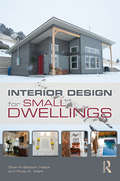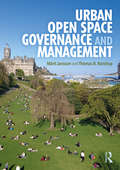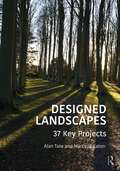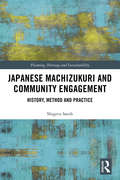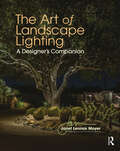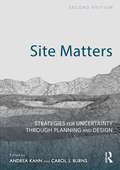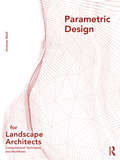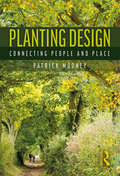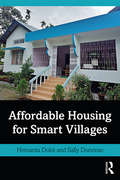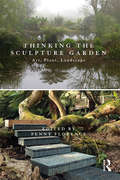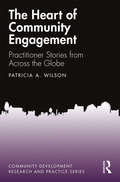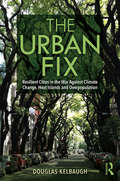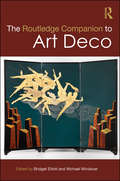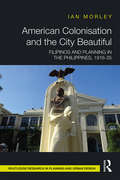- Table View
- List View
Interior Design for Small Dwellings
by Sherrill Baldwin Halbe Rose K MarkInterior Design for Small Dwellings addresses the onrush of interest in smaller homes and the possibility that small dwellings might be the answer to housing needs and sustainability. The book explores key principles essential to residing and designing small interiors with emphasis on client involvement and implementation of participatory, inclusive design as advocated by the Council for Interior Design Accreditation. Does living in a small space mean living small? The authors believe that by simplifying one’s life intelligently and applying certain principles of design, planning and organization, one can actually live a meaningful life in a smaller space. These tenets are based on the authors’ professional experiences and living in small homes. To this end, the book provides discussion, images, case studies, interviews, worksheets, activities and suggested explorations. Interior Design for Small Dwellings is a teaching guide and provides information and exercises that help professional designers utilize design theory, space planning and programming techniques. Throughout, the text affords sustainability, biophilic design and wellness methodologies.
Urban Open Space Governance and Management
by Märit Jansson Thomas B. RandrupThis edited volume defines and compares central aspects of governance and management related to urban open spaces (UOSs) such as long-term management, combined governance and management and strategic management of UOSs. Perspectives such as ethical considerations, user participation and changes in local governmental structures frame the governance and management of UOSs. Jansson and Randrup create a comprehensive resource detailing global trends from framing and understanding to finally practising UOS governance and management. They conclude by promoting positive changes, such as proactive management and strategic maintenance plans to encourage the creation of more sustainable cities. Illustrated in full colour throughout, this book is an essential read for students and academics of landscape architecture, planning and urban design, as well as those with a particular interest in governance and management of UOSs.
Designed Landscapes: 37 Key Projects
by Alan Tate Marcella EatonDesigned Landscapes is a case-by-case study of 37 significant, existing works of landscape design worldwide, largely constructed since the Renaissance. Being an informative and easy-to-read reference volume for practitioners and students alike, it presents key precedents in landscape architecture using site plans and recent photographs to showcase each project. Organised and presented in 12 sections based on project type, each project is examined based on date, previous site condition, designer(s), design intentions, current composition, unique features, ownership and management, and comparable projects. Each chapter offers an insightful critique of the featured projects. Written by the authors of Great City Parks, the book posits that these carefully selected key projects have maintained their status throughout the ages because they express values and design intentions that continue to inform the practice of the landscape architecture in the present day. The book concludes with a ten-point summary of lessons for professional practice gleaned from the studies. Including a wide range of case studies from countries including many in western Europe, the United States, Canada, India, Japan and China, and lavishly illustrated with over 200 full-colour images, the book is a must-have volume for anyone interested in the history and current practice of landscape architecture.
Urban Open Space Governance and Management
by Märit Jansson Thomas B. RandrupThis edited volume defines and compares central aspects of governance and management related to urban open spaces (UOSs) such as long-term management, combined governance and management and strategic management of UOSs. Perspectives such as ethical considerations, user participation and changes in local governmental structures frame the governance and management of UOSs. Jansson and Randrup create a comprehensive resource detailing global trends from framing and understanding to finally practising UOS governance and management. They conclude by promoting positive changes, such as proactive management and strategic maintenance plans to encourage the creation of more sustainable cities. Illustrated in full colour throughout, this book is an essential read for students and academics of landscape architecture, planning and urban design, as well as those with a particular interest in governance and management of UOSs.
Designed Landscapes: 37 Key Projects
by Alan Tate Marcella EatonDesigned Landscapes is a case-by-case study of 37 significant, existing works of landscape design worldwide, largely constructed since the Renaissance. Being an informative and easy-to-read reference volume for practitioners and students alike, it presents key precedents in landscape architecture using site plans and recent photographs to showcase each project. Organised and presented in 12 sections based on project type, each project is examined based on date, previous site condition, designer(s), design intentions, current composition, unique features, ownership and management, and comparable projects. Each chapter offers an insightful critique of the featured projects. Written by the authors of Great City Parks, the book posits that these carefully selected key projects have maintained their status throughout the ages because they express values and design intentions that continue to inform the practice of the landscape architecture in the present day. The book concludes with a ten-point summary of lessons for professional practice gleaned from the studies. Including a wide range of case studies from countries including many in western Europe, the United States, Canada, India, Japan and China, and lavishly illustrated with over 200 full-colour images, the book is a must-have volume for anyone interested in the history and current practice of landscape architecture.
Japanese Machizukuri and Community Engagement: History, Method and Practice (Planning, Heritage and Sustainability)
by Shigeru SatohOver the past few decades, Japan has faced severe earthquake disasters, an increasing aging population, declining birth rates, and widening social disparities. These issues have served to highlight gaps left by top-down governance approaches and the urgent need to create resilient societies using more traditional models. Japanese “machizukuri” has developed to become an exceptional example of bottom-up creative approaches based on collective action and use of local resources. Since its evolution in the 1960s, machizukuri has come to define diverse and creative community-driven management models, by which local communities are enabled to actively tackle problem-solving. Including contributions from experts directly engaged in the process, this book explores the original development of machizukuri in Japan, its diffusion through East Asia and the positive outcomes of this transfer. Combining theoretical explanations with practical case studies, from pre-disaster planning in Tokyo, to the revitalization of historic towns and rural areas around Japan, the book looks at specific solutions, tools, and links between academics, communities, organizations, governmental bodies, and the private sector. It will appeal to researchers in planning, community engagement, architecture, urban design, and sustainable development.
The Art of Landscape Lighting: A Designer's Companion
by Janet Lennox MoyerFollowing on from the critically acclaimed The Landscape Lighting Book, this is the lighting design companion every professional and student in landscape architecture needs. Written by an award-winning internationally renowned landscape lighting designer, with over 40 years’ experience in professional practice, The Art of Landscape Lighting takes the reader step-by-step through Janet Lennox Moyer’s design process. Personal and accessible in tone, the book covers tools, equipment, techniques, effects, installation, design composition and challenges using built case studies spanning the author’s career. Each project takes you through the process of how to plan compositions; selecting what should be lit and what should remain unlit; how to prioritize the importance of multiple elements; balancing brightness relationships; providing visual transportation across scenes; lighting the same space in different ways and, importantly, guidance on when designs are complete. Lavishly designed and illustrated with 450 full colour photographs, showcasing projects from start to finish, it additionally includes new landscape lighting equipment and techniques developed by Moyer throughout her career. This includes shore scraping, rainwall lighting, approaches for lighting water features and sculptures, and the 3-prong stake. Aimed at practicing professionals and students in landscape architecture, this book is the must-have inspirational resource that provides you with everything you need to design and implement landscape lighting across multiple scales.
Site Matters: Strategies for Uncertainty Through Planning and Design
by Andrea Kahn Carol J. BurnsIn the era of the Anthropocene, site matters are more pressing than ever. Building on the concepts, theories, and multi-disciplinary approaches raised in the first edition, this publication strives to address the changes that have taken place over the last 15 years with new material to complement and re-position the initial volume. Reaching across design disciplines, this highly illustrated anthology assembles essays from architects, landscape architects, urban designers, planners, historians, and artists to explore ways to physically and conceptually engage site. Thoughtful discourse and empirically grounded pieces combine to provide the language and theory to contextualize the meanings of site in the built environment. The increasingly complex hybridity of constructed environments today demands new tools for thinking about and working with site. Drawing contributions from outside and within the traditional design disciplines, this edition will trace important developments in site thinking with new essays on topics such as climate change, landscape as infrastructure, shifts from global to planetary urbanization debates, and the proliferation of participatory site transformation practices. Edited by two leading practitioners and academics, Site Matters juxtaposes timeless contributions from individuals including Elizabeth Meyer, Robert Beauregard, and Robin Dripps with original new writings from Peter Marcuse, Jane Wolff, Neil Brenner, and Thaisa Way, amongst others, to recontextualize and reignite the debate around site. An ideal text for students, academics, and researchers interested in site and design theory.
Parametric Design for Landscape Architects: Computational Techniques and Workflows
by Andrew MadlParametric Design for Landscape Architects provides a sequence of tutorial-based workflows for the creation and utilization of algorithmic tools calibrated toward the field of landscape architecture. Contemporary practice and projective theory in landscape architecture require the processing and design of data associated with complex systems to adequately represent composite, emergent scenarios. Aligning to both traditional and nascent processes of analysis and digital modeling, this book unpacks and decodes the characterization of algorithmic-based automation, leveraging software that is widely accessible in both academia and professional practice. Curated throughout are workflows that apply to a multiplex of computation programs that widely support the design, analysis, and production of landscapes, primarily concentrated on digital modeling tools Grasshopper and Rhinoceros. It is a much-needed, visually accessible resource to aid in more efficient understanding and creation of tools that automate and re-examine traditional calculations, analyses, drawing standards, form-finding strategies, fabrication preparations, and speculative assessments/simulation. This primer provides professionals and students with multifaceted skill-sets that, when applied in practice, expand and expedite conventional and speculative design workflows applicable to spatial design, and more specifically landscape architecture. The book includes over 200 full-colour drawings, images, and tables to illustrate and support examples throughout.
Japanese Machizukuri and Community Engagement: History, Method and Practice (Planning, Heritage and Sustainability)
by Shigeru SatohOver the past few decades, Japan has faced severe earthquake disasters, an increasing aging population, declining birth rates, and widening social disparities. These issues have served to highlight gaps left by top-down governance approaches and the urgent need to create resilient societies using more traditional models. Japanese “machizukuri” has developed to become an exceptional example of bottom-up creative approaches based on collective action and use of local resources. Since its evolution in the 1960s, machizukuri has come to define diverse and creative community-driven management models, by which local communities are enabled to actively tackle problem-solving. Including contributions from experts directly engaged in the process, this book explores the original development of machizukuri in Japan, its diffusion through East Asia and the positive outcomes of this transfer. Combining theoretical explanations with practical case studies, from pre-disaster planning in Tokyo, to the revitalization of historic towns and rural areas around Japan, the book looks at specific solutions, tools, and links between academics, communities, organizations, governmental bodies, and the private sector. It will appeal to researchers in planning, community engagement, architecture, urban design, and sustainable development.
The Art of Landscape Lighting: A Designer's Companion
by Janet Lennox MoyerFollowing on from the critically acclaimed The Landscape Lighting Book, this is the lighting design companion every professional and student in landscape architecture needs. Written by an award-winning internationally renowned landscape lighting designer, with over 40 years’ experience in professional practice, The Art of Landscape Lighting takes the reader step-by-step through Janet Lennox Moyer’s design process. Personal and accessible in tone, the book covers tools, equipment, techniques, effects, installation, design composition and challenges using built case studies spanning the author’s career. Each project takes you through the process of how to plan compositions; selecting what should be lit and what should remain unlit; how to prioritize the importance of multiple elements; balancing brightness relationships; providing visual transportation across scenes; lighting the same space in different ways and, importantly, guidance on when designs are complete. Lavishly designed and illustrated with 450 full colour photographs, showcasing projects from start to finish, it additionally includes new landscape lighting equipment and techniques developed by Moyer throughout her career. This includes shore scraping, rainwall lighting, approaches for lighting water features and sculptures, and the 3-prong stake. Aimed at practicing professionals and students in landscape architecture, this book is the must-have inspirational resource that provides you with everything you need to design and implement landscape lighting across multiple scales.
Site Matters: Strategies for Uncertainty Through Planning and Design
by Andrea Kahn Carol J. BurnsIn the era of the Anthropocene, site matters are more pressing than ever. Building on the concepts, theories, and multi-disciplinary approaches raised in the first edition, this publication strives to address the changes that have taken place over the last 15 years with new material to complement and re-position the initial volume. Reaching across design disciplines, this highly illustrated anthology assembles essays from architects, landscape architects, urban designers, planners, historians, and artists to explore ways to physically and conceptually engage site. Thoughtful discourse and empirically grounded pieces combine to provide the language and theory to contextualize the meanings of site in the built environment. The increasingly complex hybridity of constructed environments today demands new tools for thinking about and working with site. Drawing contributions from outside and within the traditional design disciplines, this edition will trace important developments in site thinking with new essays on topics such as climate change, landscape as infrastructure, shifts from global to planetary urbanization debates, and the proliferation of participatory site transformation practices. Edited by two leading practitioners and academics, Site Matters juxtaposes timeless contributions from individuals including Elizabeth Meyer, Robert Beauregard, and Robin Dripps with original new writings from Peter Marcuse, Jane Wolff, Neil Brenner, and Thaisa Way, amongst others, to recontextualize and reignite the debate around site. An ideal text for students, academics, and researchers interested in site and design theory.
Parametric Design for Landscape Architects: Computational Techniques and Workflows
by Andrew MadlParametric Design for Landscape Architects provides a sequence of tutorial-based workflows for the creation and utilization of algorithmic tools calibrated toward the field of landscape architecture. Contemporary practice and projective theory in landscape architecture require the processing and design of data associated with complex systems to adequately represent composite, emergent scenarios. Aligning to both traditional and nascent processes of analysis and digital modeling, this book unpacks and decodes the characterization of algorithmic-based automation, leveraging software that is widely accessible in both academia and professional practice. Curated throughout are workflows that apply to a multiplex of computation programs that widely support the design, analysis, and production of landscapes, primarily concentrated on digital modeling tools Grasshopper and Rhinoceros. It is a much-needed, visually accessible resource to aid in more efficient understanding and creation of tools that automate and re-examine traditional calculations, analyses, drawing standards, form-finding strategies, fabrication preparations, and speculative assessments/simulation. This primer provides professionals and students with multifaceted skill-sets that, when applied in practice, expand and expedite conventional and speculative design workflows applicable to spatial design, and more specifically landscape architecture. The book includes over 200 full-colour drawings, images, and tables to illustrate and support examples throughout.
Planting Design: Connecting People and Place
by Patrick MooneyLandscape designers have long understood the use of plants to provide beauty, aesthetic pleasure and visual stimulation while supporting a broad range of functional goals. However, the potential for plants in the landscape to elicit human involvement and provide mental stimulation and restoration is much less well understood. This book meshes the art of planting design with an understanding of how humans respond to natural environments. Beginning with an understanding of human needs, preferences and responses to landscape, the author interprets the ways in which an understanding of the human-environment interaction can inform planting design. Many of the principles and techniques that may be used in planting design are beautifully illustrated in full colour with examples by leading landscape architects and designers from the United Kingdom, Europe, North America and Asia, including: Andrea Cochran, Andrea Cochran Landscape Architecture, San Francisco, CA Design Workshop Inc. Richard Hartlage, Land Morphology, Seattle, WA Shunmyo Masuno, Japan Landscape Consultants Ltd., Yokohama Piet Oudolf, Hummelo, The Netherlands Melody Redekop, Vancouver Christine Ten Eyck, Ten Eyck Landscape Architects Inc., Austin, TX Kongjian Yu, Turenscape Ltd., Beijing. The book stimulates thought, provides new direction and assists the reader to find their own unique design voice. Because there are many valid processes and intentions for landscape design, the book is not intended to be overly prescriptive. Rather than presenting a strict design method and accompanying set of rules, Planting Design provides information, insight and inspiration as a basis for developing the individual designer’s own expression in this most challenging of art forms.
Planting Design: Connecting People and Place
by Patrick MooneyLandscape designers have long understood the use of plants to provide beauty, aesthetic pleasure and visual stimulation while supporting a broad range of functional goals. However, the potential for plants in the landscape to elicit human involvement and provide mental stimulation and restoration is much less well understood. This book meshes the art of planting design with an understanding of how humans respond to natural environments. Beginning with an understanding of human needs, preferences and responses to landscape, the author interprets the ways in which an understanding of the human-environment interaction can inform planting design. Many of the principles and techniques that may be used in planting design are beautifully illustrated in full colour with examples by leading landscape architects and designers from the United Kingdom, Europe, North America and Asia, including: Andrea Cochran, Andrea Cochran Landscape Architecture, San Francisco, CA Design Workshop Inc. Richard Hartlage, Land Morphology, Seattle, WA Shunmyo Masuno, Japan Landscape Consultants Ltd., Yokohama Piet Oudolf, Hummelo, The Netherlands Melody Redekop, Vancouver Christine Ten Eyck, Ten Eyck Landscape Architects Inc., Austin, TX Kongjian Yu, Turenscape Ltd., Beijing. The book stimulates thought, provides new direction and assists the reader to find their own unique design voice. Because there are many valid processes and intentions for landscape design, the book is not intended to be overly prescriptive. Rather than presenting a strict design method and accompanying set of rules, Planting Design provides information, insight and inspiration as a basis for developing the individual designer’s own expression in this most challenging of art forms.
Affordable Housing for Smart Villages
by Hemanta Doloi Sally DonovanThis book initiates a fresh discussion of affordability in rural housing set in the context of the rapidly shifting balance between rural and urban populations. It conceptualises affordability in rural housing along a spectrum that is interlaced with cultural and social values integral to rural livelihoods at both personal and community level. Developed around four intersecting themes: explaining houses and housing in rural settings; exploring affordability in the context of aspirations and vulnerability; rural development agendas involving housing and communities; and construction for resilience in rural communities, the book provides an overview of some of the little understood and sometimes counter-intuitive best practices on rural affordability and affordable housing that have emerged in developing economies over the last thirty years. Drawing on practice-based evidence this book presents innovative ideas for harnessing rural potential, and empowering rural communities with added affordability and progressive development in the context of housing and improved living standards. For a student aspiring to work in rural areas in developing countries it is an introduction to and map of some key solutions around the critical area of affordable housing For the rural development professional, it provides a map of a territory they rarely see because they are absorbed in a particular rural area or project For the academic looking to expand their activities into rural areas, especially in rural housing, it provides a handy introduction to a body of knowledge serving 47% of the world's population, and how this differs from urban practice For the policy makers, it provides a map for understanding the dynamics around rural affordability, growth potential and community aspirations helping them to devise appropriate intervention programs on rural housing and development
Thinking the Sculpture Garden: Art, Plant, Landscape
by Penny FlorenceThis innovative book poses two, deceptively simple, questions: what is a sculpture garden, and what happens when you give equal weight to the main elements of landscape, planting and artwork? Its wide-ranging frame of reference, including the USA, Europe and Japan, is brought into focus through Tremenheere Sculpture Garden, Cornwall, with which the book begins and ends. Effectively less than 15 years old, and largely the work of one man, Tremenheere affords an opportunity to examine as work-in-progress the creation of a new kind of sculpture garden. Including a historical overview, the book traverses multiple ways of seeing and experiencing sculpture gardens, culminating in an exploration of their relevance as 'cultural ecology' in the context of globalisation, urbanisation and climate change. The thinking here is non-dualist and broadly aligned with New Materialisms and Material Feminisms to explore our place as humans in the non-human world on which we depend. Eminent contributors, including John Dixon Hunt, George Descombes, Bernard Lassus and David Leatherbarrow, approach these issues through practices and theories of landscape architecture; garden and art making; history and writing; and philosophy. Richly illustrated with over 100 images, including a colour plate section, the book will primarily appeal to those engaged in professional or academic research, along with sculpture garden visitors, who will find new and surprising ways of experiencing plants and art in natural and urban settings.
Affordable Housing for Smart Villages
by Hemanta Doloi Sally DonovanThis book initiates a fresh discussion of affordability in rural housing set in the context of the rapidly shifting balance between rural and urban populations. It conceptualises affordability in rural housing along a spectrum that is interlaced with cultural and social values integral to rural livelihoods at both personal and community level. Developed around four intersecting themes: explaining houses and housing in rural settings; exploring affordability in the context of aspirations and vulnerability; rural development agendas involving housing and communities; and construction for resilience in rural communities, the book provides an overview of some of the little understood and sometimes counter-intuitive best practices on rural affordability and affordable housing that have emerged in developing economies over the last thirty years. Drawing on practice-based evidence this book presents innovative ideas for harnessing rural potential, and empowering rural communities with added affordability and progressive development in the context of housing and improved living standards. For a student aspiring to work in rural areas in developing countries it is an introduction to and map of some key solutions around the critical area of affordable housing For the rural development professional, it provides a map of a territory they rarely see because they are absorbed in a particular rural area or project For the academic looking to expand their activities into rural areas, especially in rural housing, it provides a handy introduction to a body of knowledge serving 47% of the world's population, and how this differs from urban practice For the policy makers, it provides a map for understanding the dynamics around rural affordability, growth potential and community aspirations helping them to devise appropriate intervention programs on rural housing and development
Thinking the Sculpture Garden: Art, Plant, Landscape
by Penny FlorenceThis innovative book poses two, deceptively simple, questions: what is a sculpture garden, and what happens when you give equal weight to the main elements of landscape, planting and artwork? Its wide-ranging frame of reference, including the USA, Europe and Japan, is brought into focus through Tremenheere Sculpture Garden, Cornwall, with which the book begins and ends. Effectively less than 15 years old, and largely the work of one man, Tremenheere affords an opportunity to examine as work-in-progress the creation of a new kind of sculpture garden. Including a historical overview, the book traverses multiple ways of seeing and experiencing sculpture gardens, culminating in an exploration of their relevance as 'cultural ecology' in the context of globalisation, urbanisation and climate change. The thinking here is non-dualist and broadly aligned with New Materialisms and Material Feminisms to explore our place as humans in the non-human world on which we depend. Eminent contributors, including John Dixon Hunt, George Descombes, Bernard Lassus and David Leatherbarrow, approach these issues through practices and theories of landscape architecture; garden and art making; history and writing; and philosophy. Richly illustrated with over 100 images, including a colour plate section, the book will primarily appeal to those engaged in professional or academic research, along with sculpture garden visitors, who will find new and surprising ways of experiencing plants and art in natural and urban settings.
The Heart of Community Engagement: Practitioner Stories from Across the Globe (Community Development Research and Practice Series)
by Patricia A. WilsonDrawing on first-hand accounts of action research in the Americas, Africa, and Asia, The Heart of Community Engagement illustrates the transformative learning journeys of exemplary catalysts for community-based change. Practitioners’ stories of community engagement for social justice in the Global South elucidate the moments of insight and transformation that deepened their practice: how to deal with uncertainty, recognize their own blind spots, become aware of what is emergent and possible in the moment, and weave an inclusive bond of love, respect, and purpose. Each successive narrative adds a deeper level of understanding of the inner practice of community engagement. The stories illuminate the reflective, or inner, practice of the outside change agent, whether a planner, designer, participatory action researcher, or community development practitioner. From a shantytown in South Africa, to a rural community in India, or an informal settlement in peri-urban Mexico, the stories focus attention on the greatest leverage point for change that we, as engaged practitioners, have: our own self-awareness. By the end of the book, the practitioners are not only aware of their own conditioned beliefs and assumptions, but have opened their minds and hearts to the complex and dynamic patterns of emergent change that is possible. This book serves as a much-needed reader of practice stories to help instructors and students find the words, concepts, and examples to talk about their own subjective experience of community engagement practice. The book applies some of the leading-edge concepts from organizational development and leadership studies to the fields of planning, design, and community engagement practice. Key concepts include the deep dive of sensing the social field, seeing the whole, and presencing the emergent future. The book also provides a creative bridge between participatory action research and design thinking: user-based design, rapid prototyping, and learning from doing.
The Urban Fix: Resilient Cities in the War Against Climate Change, Heat Islands and Overpopulation
by Douglas KelbaughCities are one of the most significant contributors to global climate change. The rapid speed at which urban centers use large amounts of resources adds to the global crisis and can lead to extreme local heat. The Urban Fix addresses how urban design, planning and policies can counter the threats of climate change, urban heat islands and overpopulation, helping cities take full advantage of their inherent advantages and new technologies to catalyze social, cultural and physical solutions to combat the epic, unprecedented challenges humanity faces. The book fills a conspicuous void in the international dialogue on climate change and heat islands by examining both the environmental benefits in developed countries and the population benefit in developing countries. Urban heat islands can be addressed in incremental, manageable steps, such as planting trees and painting roofs white, which provide a more concrete and proactive sense of progress for policymakers and practitioners. This book is invaluable to anyone searching for a better understanding of the impact of resilient cities in the monumental and urgent fight against climate change, and provides the tools to do so.
The Heart of Community Engagement: Practitioner Stories from Across the Globe (Community Development Research and Practice Series)
by Patricia A. WilsonDrawing on first-hand accounts of action research in the Americas, Africa, and Asia, The Heart of Community Engagement illustrates the transformative learning journeys of exemplary catalysts for community-based change. Practitioners’ stories of community engagement for social justice in the Global South elucidate the moments of insight and transformation that deepened their practice: how to deal with uncertainty, recognize their own blind spots, become aware of what is emergent and possible in the moment, and weave an inclusive bond of love, respect, and purpose. Each successive narrative adds a deeper level of understanding of the inner practice of community engagement. The stories illuminate the reflective, or inner, practice of the outside change agent, whether a planner, designer, participatory action researcher, or community development practitioner. From a shantytown in South Africa, to a rural community in India, or an informal settlement in peri-urban Mexico, the stories focus attention on the greatest leverage point for change that we, as engaged practitioners, have: our own self-awareness. By the end of the book, the practitioners are not only aware of their own conditioned beliefs and assumptions, but have opened their minds and hearts to the complex and dynamic patterns of emergent change that is possible. This book serves as a much-needed reader of practice stories to help instructors and students find the words, concepts, and examples to talk about their own subjective experience of community engagement practice. The book applies some of the leading-edge concepts from organizational development and leadership studies to the fields of planning, design, and community engagement practice. Key concepts include the deep dive of sensing the social field, seeing the whole, and presencing the emergent future. The book also provides a creative bridge between participatory action research and design thinking: user-based design, rapid prototyping, and learning from doing.
The Urban Fix: Resilient Cities in the War Against Climate Change, Heat Islands and Overpopulation
by Douglas KelbaughCities are one of the most significant contributors to global climate change. The rapid speed at which urban centers use large amounts of resources adds to the global crisis and can lead to extreme local heat. The Urban Fix addresses how urban design, planning and policies can counter the threats of climate change, urban heat islands and overpopulation, helping cities take full advantage of their inherent advantages and new technologies to catalyze social, cultural and physical solutions to combat the epic, unprecedented challenges humanity faces. The book fills a conspicuous void in the international dialogue on climate change and heat islands by examining both the environmental benefits in developed countries and the population benefit in developing countries. Urban heat islands can be addressed in incremental, manageable steps, such as planting trees and painting roofs white, which provide a more concrete and proactive sense of progress for policymakers and practitioners. This book is invaluable to anyone searching for a better understanding of the impact of resilient cities in the monumental and urgent fight against climate change, and provides the tools to do so.
The Routledge Companion to Art Deco (Routledge Art History and Visual Studies Companions)
by Bridget Elliott Michael WindoverScholarly interest in Art Deco has grown rapidly over the past fifty years, spanning different academic disciplines. This volume provides a guide to the current state of the field of Art Deco research by highlighting past accomplishments and promising new directions. Chapters are presented in five sections based on key concepts: migration, public culture, fashion, politics, and Art Deco’s afterlife in heritage restoration and new media. The book provides a range of perspectives on and approaches to these issues, as well as to the concept of Art Deco itself. It highlights the slipperiness of Art Deco yet points to its potential to shed new light on the complexities of modernity.
American Colonisation and the City Beautiful: Filipinos and Planning in the Philippines, 1916-35
by Ian MorleyAmerican Colonisation and the City Beautiful explores the history of city planning and the evolution of the built environment in the Philippines between 1916 and 1935. In so doing, it highlights the activities of the Bureau of Public Works’ Division of Architecture as part of Philippine national development and decolonisation. Morley provides new archival materials which deliver significant insight into the dynamics associated with both governance and city planning during the American colonial era in the Philippines, with links between prominent American university educators and Filipino architecture students. The book discusses the two cities of Tayabas and Iloilo which highlight the significant role in the urban design of places beyond the typical historiographical focus of Manila and Baguio. These examples will aid in further understanding the appearance and meaning of Philippine cities during an important era in the nation’s history. Including numerous black and white images, this book is essential for academics, researchers and students of city and urban planning, the history and development of Southeast Asia and those interested in colonial relations.
